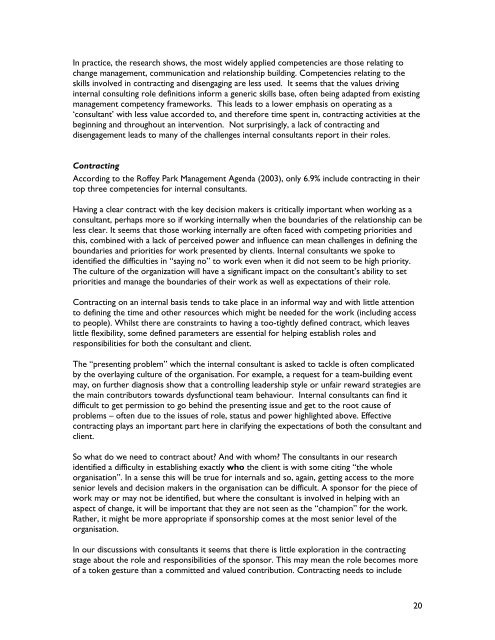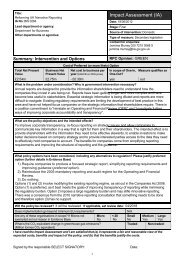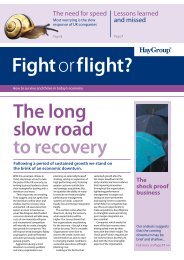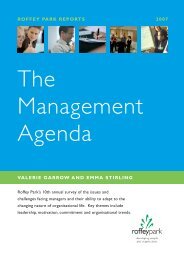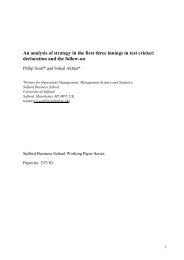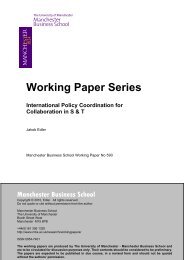The Role of the Internal Consultant - Management & Business ...
The Role of the Internal Consultant - Management & Business ...
The Role of the Internal Consultant - Management & Business ...
- No tags were found...
You also want an ePaper? Increase the reach of your titles
YUMPU automatically turns print PDFs into web optimized ePapers that Google loves.
In practice, <strong>the</strong> research shows, <strong>the</strong> most widely applied competencies are those relating tochange management, communication and relationship building. Competencies relating to <strong>the</strong>skills involved in contracting and disengaging are less used. It seems that <strong>the</strong> values drivinginternal consulting role definitions inform a generic skills base, <strong>of</strong>ten being adapted from existingmanagement competency frameworks. This leads to a lower emphasis on operating as a‘consultant’ with less value accorded to, and <strong>the</strong>refore time spent in, contracting activities at <strong>the</strong>beginning and throughout an intervention. Not surprisingly, a lack <strong>of</strong> contracting anddisengagement leads to many <strong>of</strong> <strong>the</strong> challenges internal consultants report in <strong>the</strong>ir roles.ContractingAccording to <strong>the</strong> R<strong>of</strong>fey Park <strong>Management</strong> Agenda (2003), only 6.9% include contracting in <strong>the</strong>irtop three competencies for internal consultants.Having a clear contract with <strong>the</strong> key decision makers is critically important when working as aconsultant, perhaps more so if working internally when <strong>the</strong> boundaries <strong>of</strong> <strong>the</strong> relationship can beless clear. It seems that those working internally are <strong>of</strong>ten faced with competing priorities andthis, combined with a lack <strong>of</strong> perceived power and influence can mean challenges in defining <strong>the</strong>boundaries and priorities for work presented by clients. <strong>Internal</strong> consultants we spoke toidentified <strong>the</strong> difficulties in “saying no” to work even when it did not seem to be high priority.<strong>The</strong> culture <strong>of</strong> <strong>the</strong> organization will have a significant impact on <strong>the</strong> consultant’s ability to setpriorities and manage <strong>the</strong> boundaries <strong>of</strong> <strong>the</strong>ir work as well as expectations <strong>of</strong> <strong>the</strong>ir role.Contracting on an internal basis tends to take place in an informal way and with little attentionto defining <strong>the</strong> time and o<strong>the</strong>r resources which might be needed for <strong>the</strong> work (including accessto people). Whilst <strong>the</strong>re are constraints to having a too-tightly defined contract, which leaveslittle flexibility, some defined parameters are essential for helping establish roles andresponsibilities for both <strong>the</strong> consultant and client.<strong>The</strong> “presenting problem” which <strong>the</strong> internal consultant is asked to tackle is <strong>of</strong>ten complicatedby <strong>the</strong> overlaying culture <strong>of</strong> <strong>the</strong> organisation. For example, a request for a team-building eventmay, on fur<strong>the</strong>r diagnosis show that a controlling leadership style or unfair reward strategies are<strong>the</strong> main contributors towards dysfunctional team behaviour. <strong>Internal</strong> consultants can find itdifficult to get permission to go behind <strong>the</strong> presenting issue and get to <strong>the</strong> root cause <strong>of</strong>problems – <strong>of</strong>ten due to <strong>the</strong> issues <strong>of</strong> role, status and power highlighted above. Effectivecontracting plays an important part here in clarifying <strong>the</strong> expectations <strong>of</strong> both <strong>the</strong> consultant andclient.So what do we need to contract about? And with whom? <strong>The</strong> consultants in our researchidentified a difficulty in establishing exactly who <strong>the</strong> client is with some citing “<strong>the</strong> wholeorganisation”. In a sense this will be true for internals and so, again, getting access to <strong>the</strong> moresenior levels and decision makers in <strong>the</strong> organisation can be difficult. A sponsor for <strong>the</strong> piece <strong>of</strong>work may or may not be identified, but where <strong>the</strong> consultant is involved in helping with anaspect <strong>of</strong> change, it will be important that <strong>the</strong>y are not seen as <strong>the</strong> “champion” for <strong>the</strong> work.Ra<strong>the</strong>r, it might be more appropriate if sponsorship comes at <strong>the</strong> most senior level <strong>of</strong> <strong>the</strong>organisation.In our discussions with consultants it seems that <strong>the</strong>re is little exploration in <strong>the</strong> contractingstage about <strong>the</strong> role and responsibilities <strong>of</strong> <strong>the</strong> sponsor. This may mean <strong>the</strong> role becomes more<strong>of</strong> a token gesture than a committed and valued contribution. Contracting needs to include20


